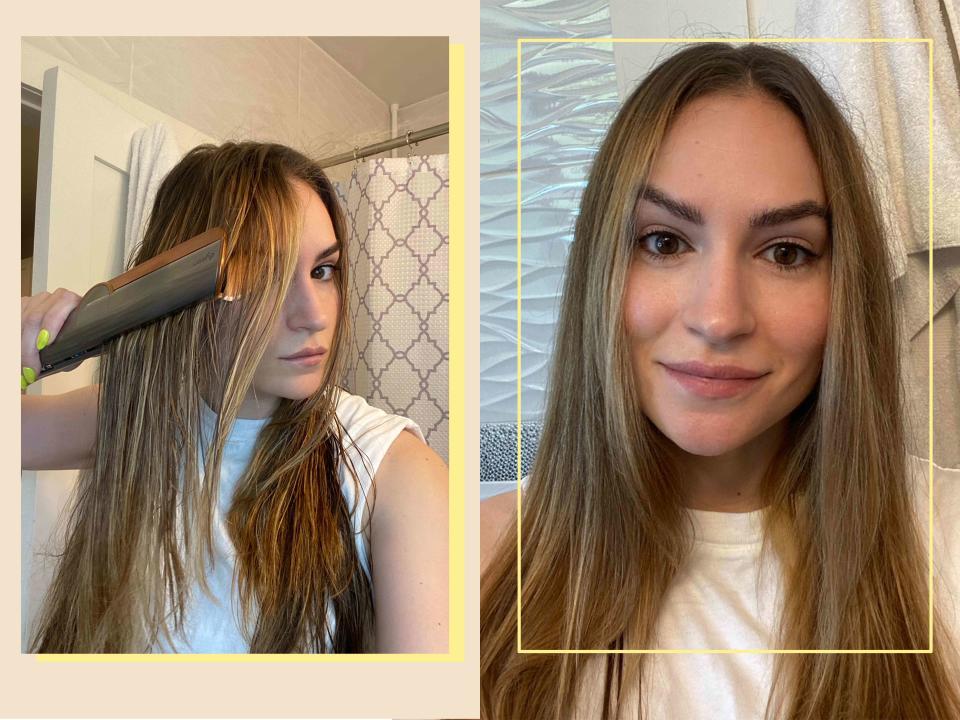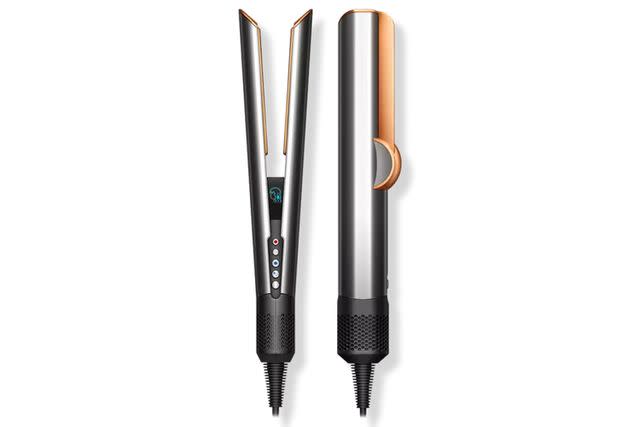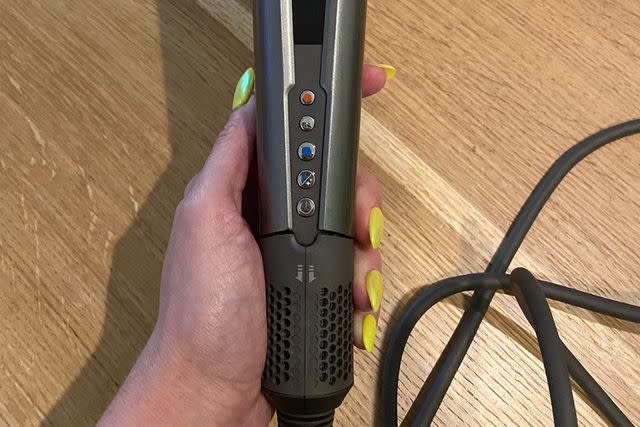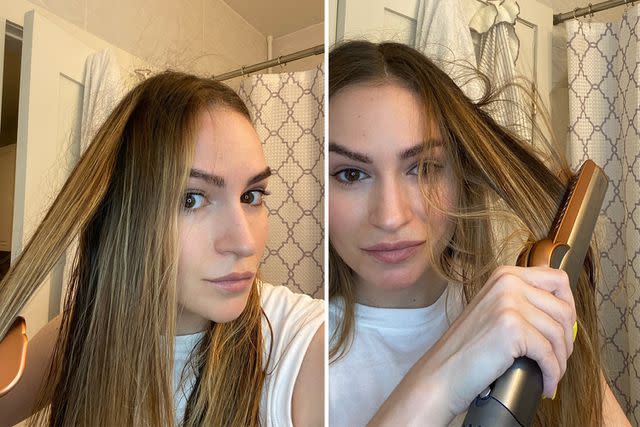I Tested Dyson's Latest, Highly Anticipated Hair Tool Launch — Here's How It Went
Dotdash Meredith and Yahoo Inc. may earn commission or revenue on some items through the links below.
A $499 tool that can take wet hair to dry and styled in minutes? Let’s see what it can do.

InStyle / Kait Clark
I’ll admit it: I’m a Dyson diehard. I’ve tested every single one of their hair tools, and even still use a few regularly. With every new launch, I give into the buzz and hype (just like everyone else) surrounding the latest sleek design, cutting edge technology, and lofty promises to totally transform your hair. And now that they’ve added another tool to their arsenal, I knew I needed to get my hands on it right away and keep my Dyson streak alive.
Enter: The Dyson Airstrait. At first blush, it looks like a pretty ordinary, although shiny and cool, flat iron, but it’s actually an exceptionally designed hybrid of a hair dryer and a hair straightener that will take your hair from wet to dry and straight within minutes.
And the best part? It straightens your hair without any hot plates. Similar to the other hairstyling tools within the Dyson roster, the Airstrait uses targeted airflow to dry your hair via dozens of little slots within the tool’s arms. With each pass from root to end, wind is blasted downward through the slots at a 45-degree angle to push moisture out of your hair, leaving it dry, smooth, straight, and damage-free.
As someone with frizzy, fine, type two hair — and a lot of it — I’ve always struggled with styling it. Hair dryers have been no help in my journey to smooth, soft strands, and usually leave me with a crown of frizzy flyaways, as if I just drove a convertible around a racetrack. Basically, I’m down to try any hair tool that promises to smooth my strands — and in far less time than drying it myself (disaster) or letting it air dry — so the Airstrait captured my full attention from the jump.
And I was also just curious how it would be different from their OG straightener, the Corrale, or the smoothing brushes you get with the Airwrap, both of which also use targeted airflow technology versus heat, and if anyone really needed to spend another $499 on a styling tool, especially if they have the others.
Dyson Airstrait

Ulta
Design
In my experience using Dyson’s three other hair tools, they’re not very intuitive to use at first. Their minimal aesthetic is certainly chic, but you sacrifice a bit of instruction with buttons that aren’t labeled. So when I tested their last tool, the Airwrap, I spent an embarrassing amount of time watching how-to videos just to get it up and running. But this time, I familiarized myself with all the features beforehand, from toggling them on and off to even just figuring out the best way to hold it to maintain control of the airflow.
One thing I couldn’t help but notice as I was monkeying around was its unwieldy, ugly, and somewhat heavy cord, a common complaint with all Dyson hair tools. But in the case of the Airstrait, I actually found the cord to be a little worse than their other tools, mostly due to the large rectangular battery, which is randomly placed right in the middle of the cord.
After powering on the Airstrait, it immediately auto-cleans to remove any residue from hair serums or oils you may have used. The process sounds like gusts of wind but lasts just a few seconds. I appreciate clean things, but I think it may be overkill to auto-clean every single time you turn it on (without the option to turn it off).
After the auto-clean is done, you select the settings you want by toggling each of the five buttons: Choose whether you’re starting with wet or dry hair, low or high airflow strength, and temperature, ranging from 175 to 285 degrees. Compared to the Corrale and nearly every other flat iron, these temps are surprisingly low — most ramp all the way up to 410 degrees — but that’s the whole point. The Airstrait effectively replaces the need for high temperatures by using high-velocity air positioned at a downward angle.

InStyle / Kait Clark
It also has a few standout safety features, like powering down to an energy-saving mode when you set it down and shutting off when you stop using it. And unlike Dyson’s other tools, this one has a very handy LCD screen above the buttons, so you always know what setting you’re on. Thin hair types can stick with a low temperature, while anyone with curly or thick hair can ramp it up to the max.
Straightening Process
I still cringe when I think of my teenage self using a hot straightener on my not totally dry hair and seeing smoke (yes, smoke) waft up. So, I was a little skeptical about going from damp to dry, so I made sure to follow Dyson’s instructions precisely, which are the exact same steps you’re likely already doing before using a hot tool. First, I washed my hair and towel dried. Next I applied a styling product (I used my favorite Philip B. leave-in conditioner). Then I picked that bad boy up and got to work.

InStyle / Kait Clark
As I powered up, I chose the highest heat setting (285) as well as the high airflow, which made a soft purring noise. I sectioned my hair and started with the front. I sandwiched my hair between the arms, beginning at the root, and as soon as I camped down, the airflow went from mild to gusty as I pulled my hair through to the ends and released the arms, which automatically triggered the airflow to go back down to the prior purr. Although Dyson recommends three passes per section to take hair from wet to dry, I needed more like five to six to get it fully dry.
I continued around my head, section by section, and before I knew it, my hair was completely dry — and straight — in less than 10 minutes, which is hands down the fastest I’ve ever gotten ready (just ask my boyfriend).
Although my hair was definitely dry and straight, it didn’t look as smooth as I had hoped. It looked kind of poofy, and I had a halo of frizz right on top of my head. My fine hair is extremely prone to frizz, so it may have just been my hair type, but my dreams were dashed. However, I should note that the frizziness eased right around the mid-shaft, and my strands were smooth all the way down to the ends.
Maybe there’s a learning curve, I thought, so I tried it again a few days later on wet hair. As I was moving the tool through my hair, I noticed that the force of the air was causing some of my shorter hairs to fly up towards my head (instead of smoothing downward), triggering the crown of frizz. I tried adjusting the downward angle and moved to the low airflow setting, but it still caused some of my thinner, finer strands to fly up.

InStyle / Kait Clark
Once I was done drying and straightening my hair, I was annoyed by the level of frizziness, but went about my day just the same. A few hours later, I caught a glimpse of myself in the mirror and saw that many of the errant hairs started to lay flat. My hair didn’t look nearly as frizzy as it did before. And once I smoothed a bit of lightweight oil from Living Proof all over, the frizz level dropped to zero. I definitely recommend waiting a bit before using a smoothing oil, just to let the hair settle on its own. Living Proof is great for fine hair like mine, but if yours is thicker or coarse, a heartier option, like this one from Kérastase, will do the trick.
Final Verdict
So, do I think it’s the Holy Grail of hair tools? Yes and no (annoying, I know).
The Airstrait is seriously great, but there are a few specific types of hair that may not benefit so much from having one, like if you have straight or mostly straight hair, to begin with. If your hair is mostly straight to begin with, you don’t need much to get it over the finish line and you can get away with a less expensive option, like the Drybar Straight Shot Blow Drying Flat Iron or the cheaper-than-Dyson-but-not-actually-cheap ghd Style 2-in-1 Hot Air Styler. And finally, if straight hair isn’t your daily (or even weekly) go-to, then you’re also probably better off spending your money elsewhere.

InStyle / Kait Clark
When I’m mulling a big ticket purchase, like this one, I consider the cost per use. Meaning that if you wash and style your hair every other day for one year, that $499 price tag breaks down to $2.74 per styling session. Plus, Dyson offers a two-year warranty, should anything go haywire. So if you’re devotee of straight styles, I can’t think of a better tool that will make your life easier, your mornings faster, and your hair looking fab (not to mention your arms less sore due to the speedy dry time), than the Airstrait. Or if you’re the type who simply cares about the health and quality of their strands, then toss your hot plate straighter in favor of this one and never look back.
Why Shop With Us
Kaitlin Clark is a senior beauty commerce editor at InStyle whose ultimate goal in life is to rock '90s supermodel hair every day. This mission has led her on a journey of testing and comparing dozens of hot tools, brushes and curling wands in search of the very best.
Related: The 14 Best Heat Protectants That Keep Styling Tools From Frying Your Hair
For more InStyle news, make sure to sign up for our newsletter!
Read the original article on InStyle.

